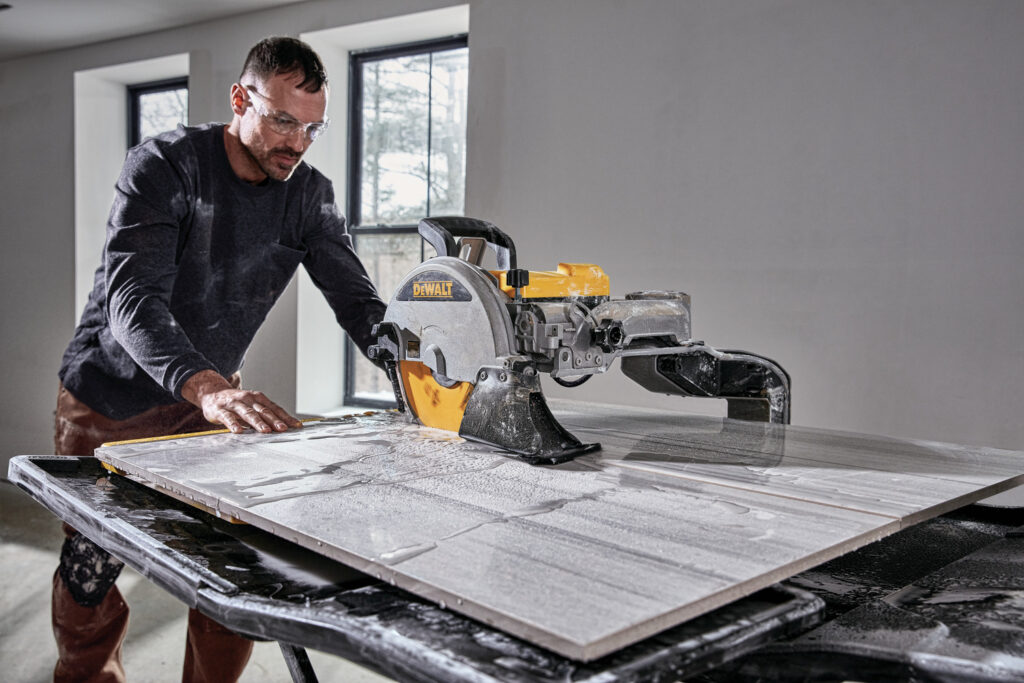Tiles need a special skill to cut. Just like other materials, they require special tools and equipment to cut them into size. Ordinary tile cutters can be used but the wet tile saw is more effective. Especially for beginners, it is the most ideal to avoid unnecessary cuttings and chipping which makes the work look ugly. Wet tile saws simply deliver faster and better results.
Why are they called wet? And why would you want them to be wet?
Like all other saws such as brick, masonry and road saws, the wet tile saws need to deliver nothing but the best.
What is a wet saw to cut a tile?
The wet tile saw, as the name suggests, is a unique saw that cuts while sprinkling water on the tile in order to make it softer. It uses a blade made of diamond to cut the tiles. It is safe especially if you want your files unchipped. To avoid dusting or burning your tiles, use a wet tile saw. Normally, water is manually sprinkled on the blade to keep it wet throughout the cutting.

Preparation
This operation can get messy sometimes because water is splashed all-over. It is wise to work outside to avoid your house getting muddy. If this is going to happen, cover your floor before starting. The place of work should have GFCI support and it should be sturdy to make it firm. Consider using a portable workbench or a picnic table to work on. Most of the experts put the blade on the ground or a slab, you can do so too. Obtain a spigot hose for a continuous supply of water.
Tools and equipment
- Indelible marker
- Hearing protectors
- Eye protectors
- Plastic bucket or pail
- Wet tile saw
- GFCI extension
Materials
- Plastic drop cloth
- Water
Instructions
1. Have a ready working area
- It should be lit and not prone to obstructions.
- It should have a water outlet.
- The floor should be covered.
- The surface should be steady and firm.

2. Prepare the saw
The saw should be filled with water to a level where the circulating pump is.
Connect fresh water using a hose spigot to the saw.
The bucket should be under the outlet.
The GFCI protection is required especially when water and electricity are both connected
Connect a drip loop to the electrical cord which comes from the saw itself.
The saw and the outlet should be a bit higher than the drip so that water won’t fall on the cord
3. Prepare to cut
Use the indelible marker or pencil with grease to mark the cutting. Adjust the guide fence to determine the width.
Align the miter to the cutting angle. Put the tile on the bed of the saw and make a flush against the miter gauge.
Align the position of the tile with the mark and make a steady pull of the tile to face the blade.
4. Cut the tile
With one eye protector and both ear protectors on, switch the saw on. Look at how water is dropping on the blade. You can adjust the stream of water at this point. Push the tile slowly into the blade which is now spinning. Slow it down as it cuts to avoid cracking while holding it with both hands side by side.
If you are cutting hard items such as porcelain, add some speed. When you are almost cutting to the end slow down to avoid destroying it at the tip. Many saws are automated and therefore wait until the saw stops then remove the tile.
5. Refresh the water as needed
Since the water reservoir may get muddy due to a repetition in cutting, it is recommended that you refresh the water. At this point, rinsing and refilling it should be done.
FAQS
How does a wet tile saw work?
It uses water and blade to cut. It contains a pump from which water is sprinkled on the blade to prevent destruction of the blade. It is teeth free hence no frequent breakages are expected

How do cut the tile with a wet saw?
Make a mark using an indelible marker. Have the fence of the sliding saw well set, align the blade well for cutting. Then, switch on the saw and check whether the water is flowing over and hold the tile while gently pushing it.
Can a wet saw cut a porcelain tile?
Other types of saws may destroy your tile and if someone is using them, he or she should be skilful though expecting issues. Adjustable saws can give better results and this credits standard depth saws for this job. These adjustments help reduce chipping.
Conclusion
For all types of ceramics and porcelain made items, I recommend wet tile saw. For smooth results compared to snap tile cutters, I still recommend the wet tile saws. However, keenness is needed because dealing with water and electricity and a diamond blade could scare you know!
However, if properly used, injuries are minimal. Wet tile saws can also be used to cut angles that are odd and to cut bevels too.






